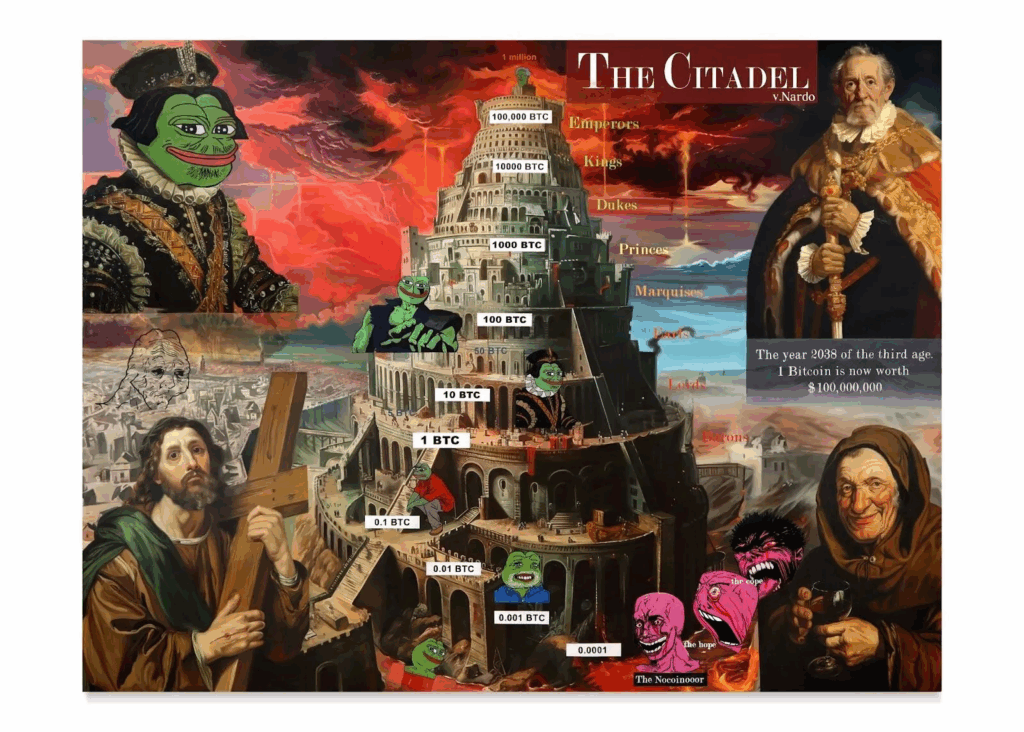Bitcoin art and Bitcoin corporations don’t seem to mix. But for decades — indeed centuries — companies have collected art to express their role in society. As early as the 15th century, the Banca Monte dei Paschi di Siena (1472) established one of the first corporate art collections. What began merely as decorative embellishment quickly evolved into a status symbol and a sign of wealth, success and cultural responsibility. Can Bitcoin-native companies gain strategic advantages through digital art? And what role does Bitcoin art play as a new asset class and cultural anchor?
Why Do Companies Collect Art?
Paintings, sculptures and installations now hang in corporate headquarters worldwide, not just to beautify walls but as statements: Art signals cultural capital and underscores a firm’s identity and values. With the rise of the digital economy, especially Bitcoin, the question arises how this tradition can continue in the 21st century.
Corporate art collections are now a fixed part of corporate culture. By the mid-2010s there were already more than 2,000 major corporate collections in North America and beyond, together worth billions. The motivations are diverse: Surprisingly, immediate financial gain is not the main driver; the tax deduction isn’t what’s motivating companies. Rather, art engagement helps firms advance strategic goals, reach new client groups, strengthen employee loyalty and enrich the quality of life around the company. In other words, art in business creates cultural capital — the value that French sociologist Pierre Bourdieu defined as the sum of cultural knowledge and prestige.
Companies that collect art therefore pursue image building and cultural promotion simultaneously. Historically, a clear pattern emerges: In the prosperous 1950s, many U.S. corporations began collecting art to make cultural statements on their newly built campuses and to support the community. The movement peaked in the 1980s, then cooled when other forms of corporate philanthropy (education, social causes) came to the fore. Yet companies that kept buying art did so under stricter criteria and with a clear purpose.

Strategic Leveraging of Art: Cultural Capital and Brand Identity
Corporate art collections fulfill several roles at once. Internally, they create inspiring environments that foster creativity and identification; externally, they serve as reputational tools: Art signals education, stability and community spirit, and art collections have long since become part of brand identity.
The best examples show that the goal is not ostentation but social value: Deutsche Bank, for instance, founded its collection in 1980 expressly to support emerging German artists. Today, it holds tens of thousands of works of international art and even operates its own museum in Berlin (the PalaisPopulaire) to stage public exhibitions. Here, art builds bridges between the company and society. JPMorgan Chase has pursued a similar concept for decades: Its “Art at Work” program, initiated in 1959 by David Rockefeller, focused deliberately on emerging and overlooked artists worldwide — an unusual approach but one that truly fosters art. Such collections are proactively built and make art central to corporate DNA rather than using it merely as decoration.
A strategically managed collection becomes a lever for cultural capital. By choosing art (including Bitcoin art) that fits the company’s philosophy, a firm can subtly communicate its values: innovation, internationality or reverence for tradition. UBS began building its corporate collection in the early 1970s as part of a commitment to cultural engagement, focusing from the outset on both established and emerging artists from across the globe. The UBS collection, for example, reflects the bank’s global reach by acquiring art from every region where it operates, including new markets such as Thailand or Korea. Guided by independent curators and an international advisory board, UBS has created a collection that represents the diversity of its communities while spotlighting young, emerging artists.
Economists see such investments as akin to other intangible assets: They raise brand value through cultural legitimacy and recognition. Firms are the new patrons: Bank collections, for instance, have gone beyond their original marketing function and now act as “new Medici”-patrons, on par with Renaissance families who once supported the arts. Especially as public cultural budgets shrink, this private patronage is more important than ever. Properly managed, corporate collections thus serve not only the firm but society at large, filling gaps left by underfunded public museums. They are, correctly used, a cultural asset for the public.

Change in the Last Ten Years: From Contemporary Art to Bitcoin Art
Recently, corporate collections have evolved mainly in content. Contemporary works — painting, sculpture, photography — still dominate, but digital art forms are increasingly gaining ground. Digital art has existed since the 1960s (from early computer-plotter drawings to video art), and collections like JPMorgan’s integrated video and media art decades ago. In the 2010s, however, blockchain technology sparked a revolution: NFTs (non-fungible tokens) made it possible to attach proof of ownership to digital artworks and trade them. Progressive companies, especially in tech, began to include digital works in their collections or even build their own NFT portfolios to underscore an innovative image.
The development, however, was not linear. The NFT boom of 2021 — fueled by spectacular auctions such as Beeple’s “Everydays” for USD 69 million — led to exuberance; many collectors, including corporations, bought digital art at peak hype. Disillusion soon followed: Since its 2021 peak, the NFT art market has collapsed by over 90 percent, from USD 2.9 billion annual turnover in 2021 to roughly USD 24 million in the first quarter of 2025. This drastic correction is reflected in the caution of established collectors. According to an Art Basel/UBS survey, the share of digital art in high-net-worth collections fell in parallel. In short, after the hype came the reality check, and companies that jumped too quickly onto the NFT bandwagon hit the brakes as the speculative bubbles burst.
This should be viewed not as an end, but as maturation. What remains is a core of serious actors and institutions that believe in the long-term potential of digital art and now collect more selectively. For corporate collections, this means digital art can now be integrated with greater prudence — not as a short-term PR stunt but as a substantive addition. Firms should focus on digital art of clear artistic quality and historical context rather than chasing every trendy NFT. New presentation formats, such as company galleries or online platforms, are being tested. The past decade has thus seen art and tech converge, with corporate collections gradually learning to view digital art as part of their concepts.
Digital Art From a Bitcoin Perspective: Status Quo and Future in Collections
Within Bitcoin, digital art opens a special chapter. For years, the NFT market played out mainly on Ethereum and other smart-contract platforms, whereas Bitcoin — conceived chiefly as a monetary system — was culturally represented more by physical objects (Casascius coins, sculptures or paintings with Bitcoin themes) and meme culture (e.g., Pepe). Yet Bitcoin-centric art projects actually predate the NFT hype: Experimental works began appearing on the Bitcoin-fork Namecoin as early as 2012, and the Colored Coins initiative in 2013 offered another way to encode and transfer digital assets on-chain. The launch of the Counterparty protocol (2014) accelerated things, with the first Counterparty-minted artworks emerging; most famous are the Rare Pepe trading cards (2016), now regarded as pioneers of crypto-art. Native experiments directly on Bitcoin Layer 1 also surfaced around 2015, but Bitcoin only captured broad public attention as a medium for digital art after the 2023 Ordinals boom. For corporate collections, this signals that Bitcoin-based digital art has deep historical roots, is clearly on the rise, and can hardly be ignored by anyone wishing to stay current.

From a Bitcoin-only perspective, digital art is viewed not merely as an asset but as a cultural expression of the ecosystem. Often described as a socioeconomic movement, Bitcoin carries its own aesthetics and ideology (decentralization, censorship resistance, HODL mentality, etc.). These values are reflected in artworks — from blockchain data visualisations to portraits of Satoshi Nakamoto to meme-infused creations. Such Bitcoin-native works could become iconic cultural goods, comparable to corporate art of earlier eras — think industrial paintings of the 19th century or propaganda art of the early modern age that accompanied economic upheavals. For current collections this means adopting Bitcoin art now is not just acquiring any digital art but a piece of financial and tech history. The 2020s are writing the artistic narrative of cryptocurrency companies. By collecting emerging and historical Bitcoin art, they can become part of that narrative and help shape it.
Why Bitcoin-Native Firms Should Collect Art and Bitcoin Art
Given these developments, why should Bitcoin companies collect art now? The answer mixes reputation, identity and responsibility. A collection can certainly burnish the image of Bitcoin firms, showing openness to culture and reducing perceptions that they are mere tech or finance nerds. More important is their active contribution to cultural formation within the Bitcoin ecosystem. Bitcoin is more than a protocol; it is a social movement with its own conferences, memes and a global community. Culture is the glue that holds such movements together. If companies like Nakamoto, Strategy or Metaplanet build collections, they create identity anchors for the Bitcoin community. A curated Bitcoin art collection can visualise the movement’s values and stories — acting like a visual manifesto.
At the same time, the companies become protagonists of this culture. Just as major banks became “new Medici” through their collections, Bitcoin firms could establish themselves as digital patrons who nurture and shape an emerging art scene. This goes beyond sponsorship: It means taking long-term responsibility for cultural heritage. In the competition for top talent and customers, that can be decisive. I mean, who wouldn’t wish to work for or invest in a company that helps shape culture and history rather than merely chase profit? A well-communicated art initiative can spark loyalty and excitement that no budget could buy, both inside the firm.
There is also an economic network effect: A vibrant cultural environment around Bitcoin increases the entire ecosystem’s appeal. The more art, music, literature and discourse exist about Bitcoin, the more firmly it becomes anchored in society. That can indirectly boost demand (people encounter Bitcoin through art), foster innovation (artists experiment with the technology) and improve public acceptance (it is not just “number go up” but a global cultural phenomenon), ultimately raising network value. Companies collecting and supporting art now invest in Bitcoin’s future viability, yielding long-term commercial benefits. Strategy, as the largest bitcoin treasury company, has an inherent interest in strengthening Bitcoin culturally as well as financially to safeguard the longevity of its holdings. Art can become a soft-power instrument, creating narrative legitimacy for Bitcoin in the broader public.
Measures: Building Museums, Scholarships, Prizes and Archives
What concrete art initiatives could Bitcoin companies pursue? Historical precedents abound.
Some banks and corporations have founded their own museums or art halls (Deutsche Bank’s PalaisPopulaire, Samsung’s Leeum Museum in Seoul). A Bitcoin company could similarly establish a Bitcoin Art Museum to exhibit outstanding works: digital projections, interactive pieces, classical paintings or sculptures with Bitcoin themes. First initiatives already point in this direction. The Bitcoin Museum in Nashville, for example, is a noteworthy early attempt to tell the story of Bitcoin through a mix of artefacts, memorabilia and artworks, to showcase the journey from Cypherpunk beginnings through the Mt. Gox era to the present. Such a museum serves as a cultural meeting point for the community and the public.
My idea for companies builds on this: to assemble collections that go beyond contemporary Bitcoin artists, tracing the intellectual history of Bitcoin in art since the 1910s. Professionally managed, these collections would be rooted in historical context, adaptable for thematic exhibitions and available for loans to strengthen both the academic recognition and the cultural presence of Bitcoin-related art.
Scholarships and prizes are powerful levers. A firm might offer an annual “Bitcoin Art Scholarship” to support talented young artists engaging with Bitcoin, or a prize for Bitcoin-based digital art (e.g., for the most innovative Ordinals project of the year). Such awards would create instant resonance in the art and crypto scenes, granting recipients greater visibility — think of the Arab Bank Switzerland Digital Art Prize.
Like major collections of the past that deliberately bought works from then unknown artists, Bitcoin companies should now seek tomorrow’s hidden champions rather than merely chasing volume without cultural value. Supporting the avant-garde of Bitcoin art today could later prove both culturally and financially rewarding: Analysts have remarked that blockchain-based digital art could become the next trillion-dollar asset class, appealing to global collectors and new investor groups.
A frequently overlooked but essential component is building archives and documentation structures. Art is only as valuable as its history is traceable — especially in the digital realm. Companies could therefore invest in archival infrastructure, for example, a database of all known Bitcoin-related artworks, with details on artists, descriptions, on-chain transaction histories and more.
Professional Support: Art Historians, Curators and Museum Practice
Ambitious and worthwhile as these plans are, companies need expertise. Collecting art and especially digital art, is not something to be handled casually by a few economists or IT specialists. Bitcoin firms wishing to invest in culture should involve artworld professionals from the start. This has tradition: the UBS collection, for instance, has been managed by curatorial experts for decades and advised by an international board. These experts know how to build a collection with a coherent narrative, assess quality and ensure proper conservation and presentation.
Digital art brings additional challenges, from questions of digital inventory to modes of display. Here, tapping museum experience pays off: A company might collaborate with media-art specialists who have already curated digital exhibitions. Art historians can bridge “new Bitcoin art” and art history, placing the collection in context. Whether avant-garde art, protest art or digital art since the 1960s, such perspective deepens understanding and helps identify artists likely to remain relevant. Continuous documentation and research further enhance cultural value.
Ethical and legal advice is another aspect. In this field, where sources of wealth are scrutinized, transparency and responsible conduct are vital. Art historians and curators ensure collections are not staged merely as PR but remain credible and respectful toward the art community. Classical corporate collections usually commit to buying art on the primary market directly from artists or galleries, thereby supporting living artists instead of chasing auction trophies. This attitude, away from quick flipping toward sustainable patronage, is advisable for Bitcoin companies. Hiring or consulting curators to design and care for the collection mirrors best practice in corporations that systematically maintain their collections.
Finally, art and culture as investments require long-term thinking. Classical art investments have historically yielded moderate returns of about 6% per year, and experts advise buying art primarily from passion, not for returns alone. The same likely holds for Bitcoin art: Its intangible gains (social influence and cultural heritage) are paramount, though financial appreciation may follow. Professional advice helps balance artistic and financial value. When both align, art collections become precisely the strategic asset that does not appear as a number on the balance sheet yet exerts enormous impact within and beyond the company.
Conclusion: A Bright Future for the Arts
In an era where the distinction between the digital and physical worlds is becoming increasingly blurred, corporate art collections are on the verge of entering a new era. Bitcoin represents not only an economic but also a cultural paradigm shift. Corporate art collections in the age of Bitcoin are more than a continuation of an old tradition with new tools; they are an opportunity to shape an emerging cultural cosmos. Historically, companies collected art to present their face to society, inspire employees and make their values tangible.
Today, Bitcoin companies can adopt these motives and infuse them with new life: By collecting digital artworks on-chain, they create cultural capital in a language that fits their business DNA. They can leverage this capital strategically to generate network effects. Each supported artist and each donated artwork strengthens the narrative of Bitcoin as not merely technology or investment but a cultural movement.
The next steps for me are clear: art scholarships for emerging Bitcoin artists; dedicated exhibition spaces online and offline; partnerships with museums and art academies; perhaps even a corporate museum. Companies should approach the task with humility and seek professional expertise. Just as a CFO is consulted for investment strategy, a curator should be consulted for art strategy. Equipped in this way, Bitcoin-focused firms could become genuine cultural actors, earning future recognition akin to today’s collections of UBS, Deutsche Bank, or JPMorgan.
The young Bitcoin art scene currently presents a historic opportunity: Its culture is still malleable, the “canvas” largely unpainted. Companies that act now can write cultural history. They will own not only digital masterpieces but also contribute to the identity of a decentralized future. Bitcoin is poised to open a new chapter; art provides the language to tell it. Corporate collections can help shape the canon. This is strategic leveraging in its noblest sense: uniting capital and culture to create something of lasting value for the company, for the community and for the future.


